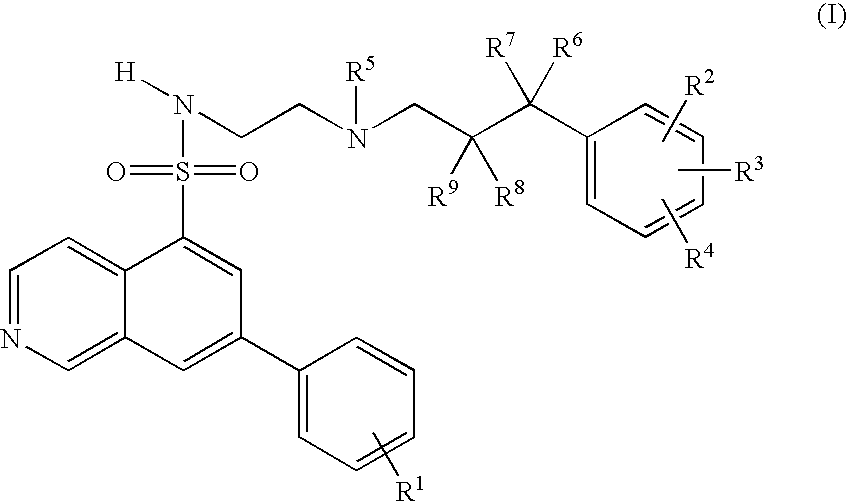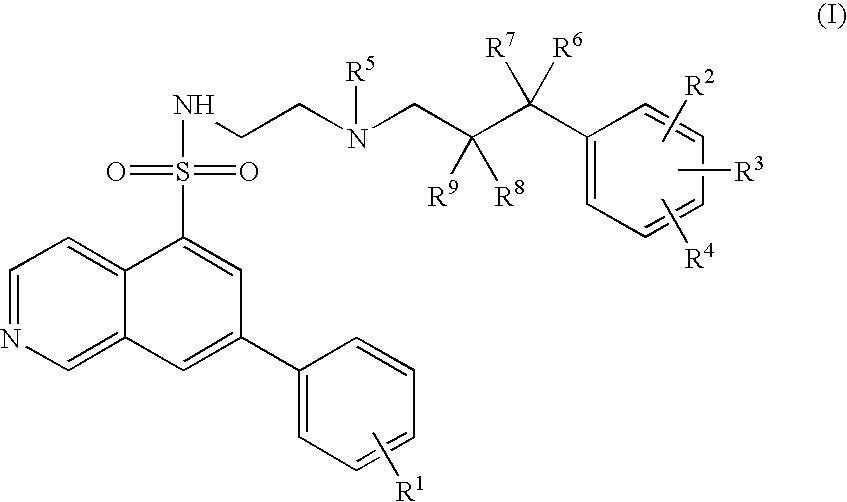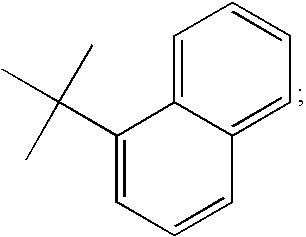7-Phenyl-isoquinoline-5-sulfonylamino derivatives as inhibitors of akt (proteinkinase b)
a technology of sulfonylamino derivatives and akt, which is applied in the direction of biocide, animal repellents, drug compositions, etc., can solve the problems of hcmv abortive production, early death, and stunted growth of littermates
- Summary
- Abstract
- Description
- Claims
- Application Information
AI Technical Summary
Benefits of technology
Problems solved by technology
Method used
Image
Examples
preparation 49
3-(4-chloro-2-pyrrolidin-1-yl-phenyl)propionaldehyde
[0198] Add pyrrolidine (0.97 g, 13.67 mmol) to a solution of 4-chloro-2-fluoro-1-nitrobenzene (2 g, 11.40 mmol) in 8 mL anhydrous DMSO under N2. Stir the reaction mixture at 80° C. for 1 h. Cool the mixture, pour into ice-H2O and extract with Et2O (3×30 mL). Wash the organic phase with water and brine, dry over MgSO4, filter, and concentrate. Chromatograph the residue on silica gel using hex / EtOAc 9:1 as eluent to afford 2.29 g (89%) of 1-(5-chloro-2-nitro-phenyl)-pyrrolidine as a yellow solid. Add tin chloride (10 g, 44.15 mmol) to a solution of 1-(5-chloro-2-nitrophenyl)pyrrolidine (2 g, 8.83 mmol) in 25 mL of EtOH under nitrogen. Heat the reaction mixture at 70° C. for 3 h. After cooling, pour the mixture into ice-water, basify (pH=9) with NH4OH, and extract with EtOAc (3×100 mL). Dry the organic phase over MgSO4, concentrate, and purify the residue by silica gel chromatography using hex / EtOAc 8:2 as eluent to obtain 1.56 g (88...
preparation 60
3-[5-Chloro-2-(3-oxopropyl)-phenoxy]-pyrrolidine-1-carboxylic acid tert butyl ester
[0201] Slowly add di-tert-butyl dicarbonate (5.5 g 25.29 mmol) to a solution of 3-hydroxypyrrolidine (2 g, 23 mmol) and triethylamine (6.45 mL, 45.98 mmol) in 30 mL of anhydrous dichloromethane under nitrogen at 0° C. Stirr the reaction mixture at ambient temperature for 16 h. After dilution with CH2Cl2, wash the organics with dilute acetic acid, saturated NaHCO3 and water. Dry over MgSO4, filter and concentrate to afford the carbamate as an orange solid (4.18 g, 97%).
[0202] To a stirred solution of 4-chloro-2-fluoro-1-nitrobenzene (2 g, 11.40 mmol) and 3-hydroxypyrrolidine-1-carboxylic acid tert-butyl ester in 40 mL of anhydrous DMF, add NaH (0.55 g, 22.79 mmol) at 0° C. in portions. Stir the mixture at room temperature for 1 h, then, pour into ice-water, extract with EtOAc (3×50 mL), dry over MgSO4 and evaporate to afford the compound pure enough to use in the following step without further purifi...
preparation 69
3-(5-chloro-3′-nitro-biphenyl-2-yl)-propionaldehyde
[0204] Heat a mixture of 2-bromo-4-chloro-phenylamine (8.24 g, 40 mmol), 3-nitrophenylboronic acid (10.0 g, 60 mmol), Pd(PPh3)4 (2.8 g) and Na2CO3 (17.0 g) in toluene (200.0 mL), EtOH (30.0 mL) and water (80.0 mL) to 80° C. (oil bath) with stirring overnight. Cool to room temperature, dilute the mixture with EtOAc, filter and concentrate. Dissolve the residue in EtOAc, wash with brine and dry over Na2SO4. Chromatograph the crude material on silica (gradient 25% EtOAc in hexane) to give 5.27 g of the desired product as a yellowish crystal.
[0205] To a solution of amine (5.27 g, 21.19) in CH2I2 (22.7 mL), add isopentyl nitrite (7.5 g, 63.57 mmol) at room temperature. Stir the mixture for 2 hours, and then heat to 80° C. for one hour. After cooling to room temperature, add piperidine (56.8 mL) and CH3CN (56.8 mL). Stir for one hour and then concentrate. Wash the residue with 10% HCl, and purify via silica gel with hexane to afford 7.0...
PUM
| Property | Measurement | Unit |
|---|---|---|
| temperature | aaaaa | aaaaa |
| temperature | aaaaa | aaaaa |
| temperature | aaaaa | aaaaa |
Abstract
Description
Claims
Application Information
 Login to View More
Login to View More - R&D
- Intellectual Property
- Life Sciences
- Materials
- Tech Scout
- Unparalleled Data Quality
- Higher Quality Content
- 60% Fewer Hallucinations
Browse by: Latest US Patents, China's latest patents, Technical Efficacy Thesaurus, Application Domain, Technology Topic, Popular Technical Reports.
© 2025 PatSnap. All rights reserved.Legal|Privacy policy|Modern Slavery Act Transparency Statement|Sitemap|About US| Contact US: help@patsnap.com



